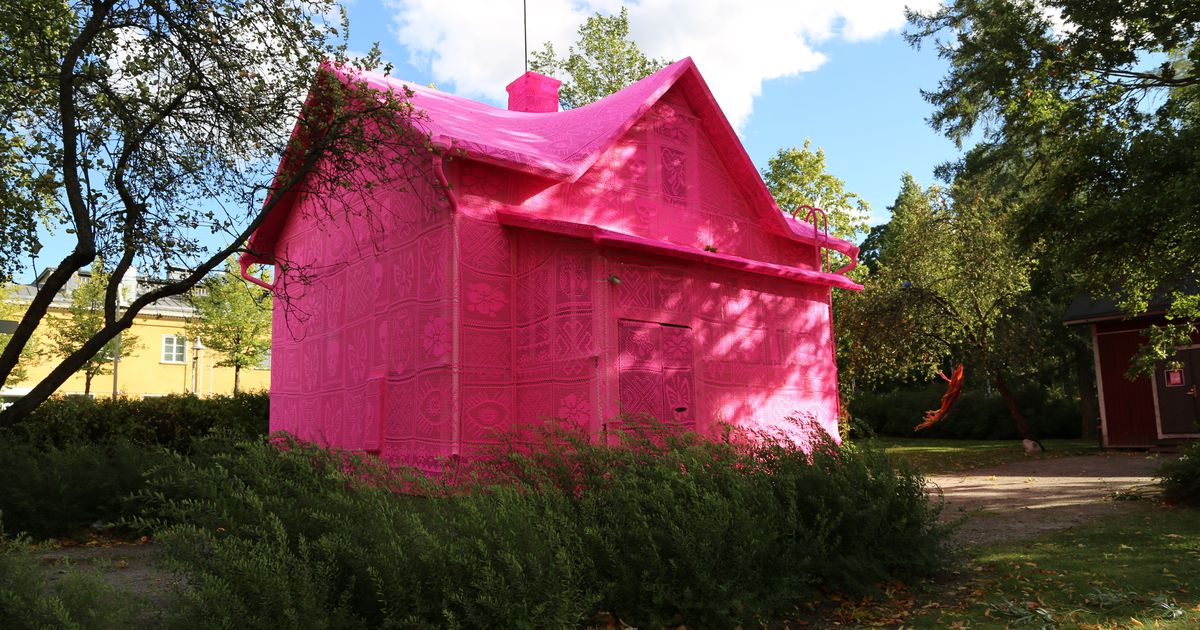Refugees covered this house in pink crochet for a powerful reason


LONDON There’s no place like home. But each day 34,000 people are forced to leave the place they call home due to conflict or persecution.
For the 21.3 million refugees currently in the world, hope is something that doesn’t always come easily. But one artist has joined forces with a group of refugee women from Syria and Ukraine in an effort to create a powerful symbol of hope for those displaced by conflict.
Initially, Polish artist Olek was tasked with building an art installation based on a traditional 19th-century Swedish home for the Verket museum in Avesta, Sweden. However, when she joined forces with a group of women refugees from Syria and Ukraine, her project grew beyond what she had first anticipated.
As Olek worked alongside these women crocheting swathes of fabric for the installation, they began to share their personal stories and photographs from their pasts.
Olek works with refugee women to create the first installation for the Verket museum in Avesta, Sweden.
Image: olek
“They showed me pictures of their houses their destroyed houses. They showed me pictures from before and after the bombs had destroyed their houses. And the women told me stories about how they ran away from war to survive,” Olek told Mashable.
“They showed me pictures from before and after the bombs had destroyed their houses.”
Olek was profoundly affected by the women’s stories and the photos they showed her.
“When the Syrian and Ukrainian refugees who helped me install my piece started telling me the candid stories of their recent experiences and horrors of their home countries, I decided to blow up my crocheted house to illustrate the current unfortunate situation worldwide, where hundreds of thousands of people are displaced,” Olek said.
When the women who had worked with Olek on the installation saw a video of it being destroyed, many were moved to tears. Olek says one woman told her that blowing up the installation was an important act in showing the world the current situation in countries torn by conflict.
The installation after it was exploded.
Image: olek
Olek didn’t want the project to end there.
After I exploded the house, I wanted to create a positive ending for them as a symbol of a brighter future for all people, especially the ones who have been displaced against their own will, Olek continued.
Olek along with the group of women got to work on the next stage of the project: building a symbol of hope. This time around, the fruits of their labour would not be blown up.

The women creating swathes of pink crochet to cover a house in Avesta, Sweden.
Image: olek
This symbol also took the form of two pink crocheted houses one in Avesta, Sweden, and another in Kerava, Finland.
However, the history of the Kerava house adds another poignant dimension to the project: the house was itself a survivor of war.

The crocheted house in Kerava, Finland.
Image: olek
During the Winter War a military conflict between the Soviet Union and Finland from 1939 to 1940 bombs fell into the property’s garden, but the house and the family living there survived.
Over the course of three weeks, a large group of volunteers and women from a reception centre for asylum seekers got together to crochet. Together with some assistance from a professional team in Poland, they produced over 300 square metres. Those swathes of bright pink crochet are now covering the house near the railway station in Kerava, from the chimney to the house’s stone base.

The refugees and volunteers who worked to crochet the houses.
Image: olek
Our pink house is about the journey, not just about the artwork itself. Its about us coming together as a community. Its about helping each other. We can show everybody that women can build houses, women can make homes,” said Olek.
“Women have the ability to recreate themselves. No matter how low life might bring us, we can get back on our feet and start anew.”
Both pink crocheted houses will be on display until the winter.
Read more: http://mashable.com/2016/09/07/refugees-crochet-house/

